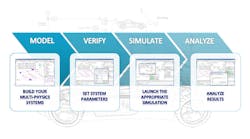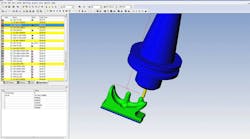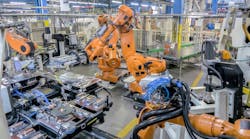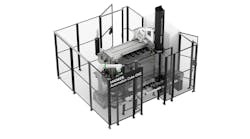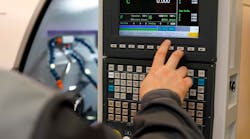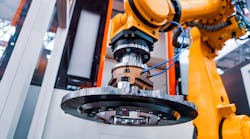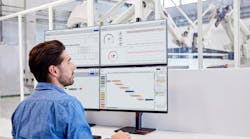The updated Redex MSR gear drives for turning tables to incorporate the newest generation of Siemens CNC and Fanuc drive and control technologies. The resulting MSR drives are comprised of two identical gearboxes (the TwinDrive system) that share the driving torque (50%-50%) during turning. With the help of the CNC system to manage the motor preload torque, the system is able to cancel 100% of backlash.
This new drive will dramatically simplify the design of turning table mechanical transmission systems. Redex – a developer of specialty mechatronics systems for machine tools — specializes in drive systems for turning and milling operations. Prior to its introduction of the MSR, turning tables were designed to use two different types of drives when a C axis was required: a main drive for turning operations, driven by a large spindle motor; and a feed-preloaded gearbox to cancel the backlash during C axis mode, which needed to be clutched and unclutched to the crown. In addition, the main drive would have to be shifted to neutral ratio.
The new MSR achieves a very accurate positioning level, so it’s able to execute additional functions on the C axis without any additional mechanical devices. For example, high accuracy is maintained during milling with one motor driving and the other motor braking.
The new design also eliminates the need for developing a complex and expensive gearbox for the C axis, including complex systems of clutching/unclutching. A solution with two motors is less expensive and easier to manage.
Compared to heavy-duty turning tables used in conventional configurations that require a 160-kW motor, the MSR uses two 80-kW motors that are more standard and less expensive (even accounting for the cost of both units.)
When the diameter of the chuck or part to machine is large, conventional kinematics would use a different stage ratio of 1/1, which result in higher operating costs and loss of efficiency. MSR kinematics allows the drive to be placed just under the chuck, directly meshing with the crown.
Spare parts management is simplified with the use of a smaller motor, and there is no need to manage the C-axis gearbox manufacturing with all its components.
The new Redex MSR drive solution is designed as a turnkey system that includes the latest-generation MSD two-speed gearbox and an improved, cubic R Series right-angle bevel gearbox. The redesign includes a more compact and reliable speed changer as well as a new lubrication arrangement.
The new range improves features of the four MSR system sizes — MSR330- MSR640- MSR650- MSR660 — with torque capacity at pinion from 2000/4000 Nm (2 x 40-Kw motors) up to 9,000/18,000Nm (2 x 100-Kw motors) with three possible ratio combinations of 7.66&2, 9.88&2, 11.49&3. This system, combined with pinion/ring ratio of about 10 to 15, offers turn table torques from 20,0000 Nm up to 270,000 Nm, and global ratios (gearbox + ring gear) of 77/20 and 172/45.

